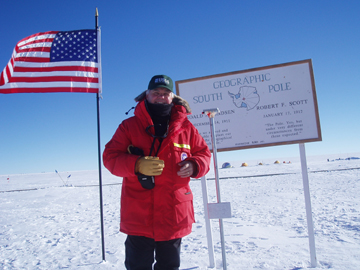 Patrick
Leahy found himself in the Antarctic in mid-January, discussing the quietest
seismic monitoring station in the world. The following week, he was at Johns
Hopkins University in Baltimore, Md., talking about avian influenza. And a week
later, Leahy stood before a small audience in Washington, D.C., to discuss the
importance of funding U.S. stream gages in the upcoming fiscal year.
Patrick
Leahy found himself in the Antarctic in mid-January, discussing the quietest
seismic monitoring station in the world. The following week, he was at Johns
Hopkins University in Baltimore, Md., talking about avian influenza. And a week
later, Leahy stood before a small audience in Washington, D.C., to discuss the
importance of funding U.S. stream gages in the upcoming fiscal year.Patrick Leahy, whose career has touched on a variety of sciences from hydrology to infectious diseases, is the acting director of the U.S. Geological Survey. Courtesy of the U.S. Geological Survey.
All this is part of Leahy’s work as acting director of the U.S. Geological Survey (USGS). Since he stepped into the position in June 2005, Leahy has traveled widely and visited a variety of sites across the United States and abroad, addressing the survey’s many and varied activities. That variety reflects the evolving interests and career of this hydrologist-turned-manager.
As current acting director, the budget remains on his radar screen. In February, despite cuts to USGS programs such as minerals commodities, Leahy said he still found budget items with which to be pleased — including increased funding to support stream gages on the continental United States, some of which have been collecting data for a century or more. Still, Leahy said, the budget contained challenges that could not be “sugarcoated” (see Geotimes online, Web Extra, Feb. 7, 2006), in what may have been a characteristic comment mixing bluntness and humor.
“He has the knack of getting to the center of what you are trying to discuss instead of working around it,” says Dan Vaupel, Leahy’s former boss at USGS in West Trenton, N.J., “which is probably a really good trait to have” as acting director. In the years that Vaupel supervised Leahy, “Pat had a unique ability [to be] always ahead of the game,” as well as “able to maintain his scientific credentials by publishing even while supervising.”
Vaupel hired Leahy in 1983 to manage three hydrology modeling projects for the state of New Jersey, after Leahy had built a groundwater model for central Delaware — an academic exercise that Leahy says he was shocked to find was still in use some 20 years later. Leahy calls that “a Eureka moment”: Pure scientific research is not always purely academic. “The geological sciences offer [researchers] a unique opportunity to see the benefit of their hard work impacting society,” he says.
As a high school student in his hometown of Troy, N.Y., Leahy grew up in the generation “where space exploration was a high priority,” he says, with emphasis on math and science at the high school level in particular. “I can’t say I started out wanting to be a hydrologist or geologist,” Leahy says, but he “wanted something quantitative” to fit his “natural” analytical bent, at a time when geology was becoming a more quantitative field, particularly in hydrology. That bent eventually led to a master’s degree in geophysics from Boston College in 1970, focusing on seismology, followed by a Ph.D. at Rensselaer Polytechnic Institute in Troy, in rock mechanics and groundwater hydraulics, taking Leahy further into numerical modeling.
“It seems to me that Pat set about preparing himself very broadly by majoring in various aspects in the earth sciences,” says James Skehan, Leahy’s first geology professor as an undergraduate at Boston College and his mentor to this day. Skehan recalls Leahy as a “proficient” student, whose first field report remains clearly in Skehan’s memory: a regional geology report on pillow basalts and other rock formations located around Boston College. “He’s a person that is ready for a challenge, whatever it may be,” Skehan says, and his diversified background “has been wonderful preparation for him.”
That variety may have served Leahy well in his nearly 40-year stint at USGS, particularly in his ability to transition between subjects. He started as a summer hire his junior year in Albany, N.Y., in 1967, and interrupted his USGS career with positions at Texaco and elsewhere. Leahy eventually served as head of the National Water Quality Assessment program and then head of the Geology Division, where he became involved in international partnerships and the USGS minerals program.
“He did kind of the unthinkable when he moved from water into geology and became chief geologist,” says Chip Groat, the former director of USGS who stepped down in June 2005 and is now at the University of Texas in Austin. That shift was “against the culture of the survey,” Groat says, but it worked, and Leahy helped to forward a multidisciplinary approach within USGS that was part of Groat’s own agenda.
As Leahy travels often and widely to visit USGS employees and stakeholders in his current position, he has talked about wildly varying and interdisciplinary issues — from the work USGS does in detecting the spread of disease in the wild, to water quality data collection and the agency’s role in studying marshlands and rebuilding New Orleans post-Hurricane Katrina. “The most lasting impression I have as acting director,” Leahy says, “is the diversity of the work that USGS does.”
Naomi Lubick
Links:
"Budget blues and bonuses," Geotimes online, Web Extra, Feb. 7, 2006

